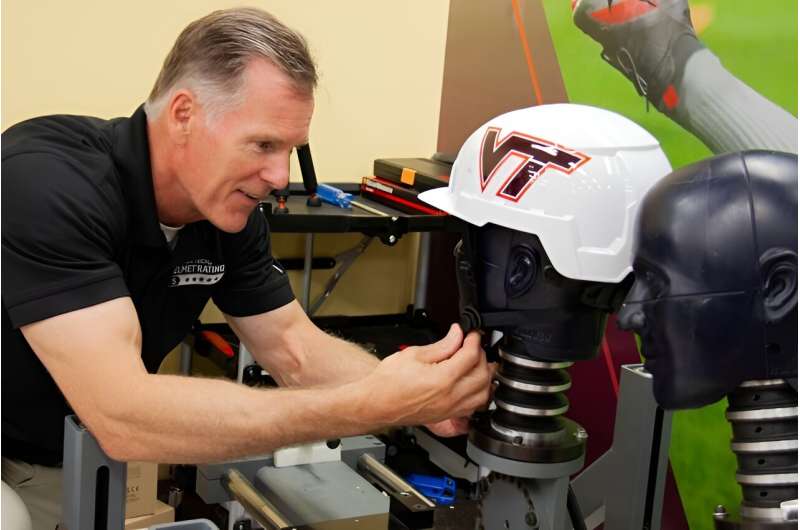
Barry Miller, director of business and outreach development in the Virginia Tech Helmet Lab, adjusts a safety helmet on a test rig. Credit: Amber Yost for Virginia Tech
Thirteen years after releasing the first independent safety ratings for varsity football helmets, the Virginia Tech Helmet Lab is expanding beyond the field of athletics.
This summer, researchers will begin an 18-month study to develop the first ratings system for safety helmets, also commonly referred to as hard hats or construction helmets. The ratings system will join the nine sports the lab already produces ratings for using their five-star scale.
The lab has conducted injury biomechanics research outside sports before, including its research on toy product safety and work with the Virginia Tech Mid-Atlantic Aviation Partnership on drone impact testing for operations over people. However, this is the first time that the lab will extend its impact by developing a ratings system to evaluate a non-sports helmet.
“Of all industries, construction has the most workplace fatalities,” said Steve Rowson, the lab’s director. “Identifying, improving, and implementing better head protection could be the difference between life and death for some of these accidents.”
From 2000–08, the construction industry was responsible for more traumatic brain injuries (TBIs) than any other industry, according to an article published in the American Journal of Preventive Medicine. These injury scenarios cause high head injury risk from the high speeds involved.
In this project, researchers will study head impact and concussion risk in a work site environment with the following objectives:
Characterize the conditions associated with head impacts in construction through analysis of accident reports and surveillance video.
Generalize the real-world loading conditions observed in the reconstructions to controlled laboratory test systems.
The lab will also use its Summation of Tests for the Analysis of Risk (STAR) model to combine data from multiple test sites and compute an overall performance score representative of expected real-world injury rates. The STAR score is calculated based on a helmet’s performance in a series of impact tests and assigned a number of stars between one and five to categorize impact performance. Impact conditions are sports-specific and inclusive of the broad range of head impacts likely to be experienced, hence the need to develop a STAR model specific to safety helmets for this project.
The lab is scheduled to complete the project by August 2025.
“We hope this work leads to fewer disabling or fatal head injuries resulting from accidents by providing stakeholders with data to make informed decisions on equipping the workers with the most effective personal protective equipment,” Rowson said.
More information:
Hope M. Tiesman et al, The Epidemiology of Fatal Occupational Traumatic Brain Injury in the U.S., American Journal of Preventive Medicine (2011). DOI: 10.1016/j.amepre.2011.03.007
Citation:
Lab expands beyond sports to develop ratings system for safety helmets (2024, June 26)
retrieved 26 June 2024
from https://medicalxpress.com/news/2024-06-lab-sports-safety-helmets.html
This document is subject to copyright. Apart from any fair dealing for the purpose of private study or research, no
part may be reproduced without the written permission. The content is provided for information purposes only.
>>> Read full article>>>
Copyright for syndicated content belongs to the linked Source : Medical Xpress – https://medicalxpress.com/news/2024-06-lab-sports-safety-helmets.html






























